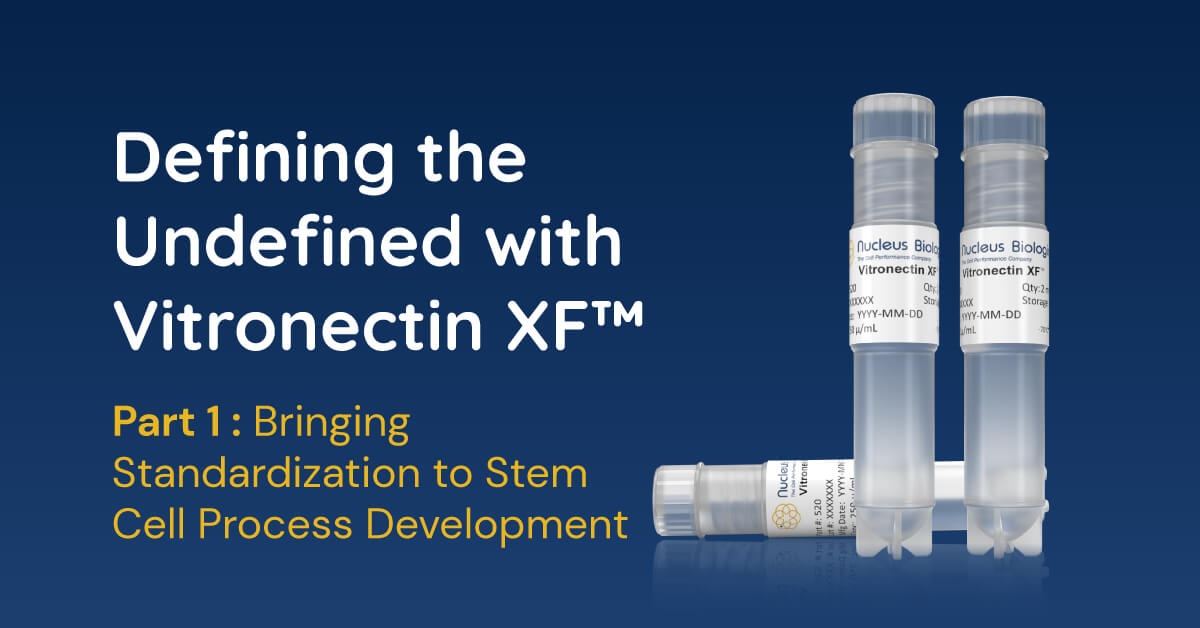Bringing Standardization to Stem Cell Process Development.
A recombinant cell attachment factor brings standardization to stem cell production.
Over the last few decades, human embryonic stem cells (hESCs) and subsequently induced pluripotent stem cells (iPSCs) have received a lot of attention for their therapeutic potential in regenerative medicine and cell therapy. However, bringing successful therapeutics to market is a complex process and one that requires a well-defined product that can be consistently replicated across multiple batches in order to secure FDA approval, or even to enter clinical trials. The problem with therapies based on living cells and tissues such as stem cells is that it is much harder to achieve this level of consistency.
In Part 1 of a 3-part blog series, Defining the Undefined with Vitronectin XF™, we discuss how Vitronectin XF, a recombinant cell attachment factor, brings standardization to stem cell production. In Part 2, we discuss jumping the regulatory hurdles with single component ECM gels, and in Part 3, we get attached to Vitronectin as we delve into its performance data compared to traditional mixed ECM gels.
Historically hESCs were cultured in medium supplemented with fetal bovine serum (FBS) on a bed of mouse embryonic fibroblasts (MEFs). The MEFs provided a feeder cell layer that created an attachment surface and secreted growth factors that helped maintain the stem cells in an undifferentiated state. However, maintaining feeder layers is not only labor intensive and inconsistent, but exposes the human stem cells to non-human (xeno) cells, biologics, and pathogens. This exposure to xeno-contamination, which could potentially go undetected in the final therapeutic product, is a hard barrier to cross when seeking regulatory approval for a new therapeutic.
Towards a Defined Media; the Role of the ECM
Our understanding of the importance of the proteins that comprise the extracellular matrix (ECM) for cell attachment and spreading has enabled a move to feeder-free systems that eliminated the problem of xeno-contamination. ECM proteins like vitronectin, fibrinogen, fibronectin, and tenascin have a conserved tri-peptide sequence that is responsible for cell adhesion via integrin receptors on the surface of the cells. It is this ECM-integrin binding that moderates the ability of cells to spread, migrate, and undergo morphological changes.
While the move to a mix of ECM proteins as a growth matrix represents a step in the right direction, it is still limited in its utility. ECM gel mixtures such as Matrigel® are a heterogeneous mix of non-human animal origin ECM proteins with other undefined extracellular components and growth factors. Because the composition can vary from lot to lot, these products still present problems for the development of cell therapies where in-depth knowledge of components, concentrations, and origin will be required for regulatory approval.
Fully Defined, Reproducible Growth Matrix
The final step in the evolution of growth matrices capable of supporting cell proliferation and pluripotency for therapeutic stem cells came with the development of the first recombinant ECM proteins. Vitronectin XF™ from Nucleus Biologics provides the same level of performance as heterogeneous ECM protein mixes such as Matrigel, but in a defined, FDA-friendly format capable of supporting mesenchymal and induced pluripotent stem cells, encouraging cell proliferation, and maintaining pluripotency while accelerating the all-important pathway for regulatory approval for complex regenerative medicine and cell therapy applications.
You can learn more about Vitronectin XF on the Nucleus Biologics website. Next week in the second part of this blog series, we discuss jumping the regulatory hurdles with single component ECM gels.




